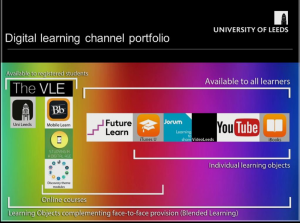Following on from my previous blog post on how the University of Manchester are using OpenCast Lecture Capture, this blog post summarises the developments in a lecture capture and multimedia management system at the University of Leeds through a series of lessons or top tips. It’s taken from a webinar recording shared via the lecture-captures@jisc-mail.ac.uk mailing list.
The University of Leeds have implemented a state-of-the-art lecture capture and multimedia management system since September 2014 using the Mediasite by Sonic Foundry, a leading video content management. The project took 142 days to implement from start to finish according to Professor Neil Morris, Director of Digital Learning at the University of Leeds.
Lesson 1: Link to Policy, Strategy and Vision
The implementation of lecture capture coincided with the formation of various policy documents, most notably the Download the Policy on Audio or Video Recording for Educational Purposes which unpinned the project and guided the very important decisions about lecture capture for staff and students. It states no students would record in lectures and that all lectures would be recorded by the University using an opt-out policy approved by senior management in the university.
Lesson 2: Create an Open Educational Resource Platform to encourage blended learning

University of Leeds has an open educational resources (OERs) policy and the ability of the video content management system to create, share and use OERs was key. The video leeds portal is an example of open educational resources available globally.
University of Leeds have the following channels where they publish videos to:
- Blackboard VLE (for registered users of the University of Leeds)
Publicly accessible:
- FutureLearn,
- Youtube,
- Jorum,
- iBooks
- iTunesU

The University finds that these objects complement the face to face teaching and hence create the required blend needed. This ability to share, disseminate courses and resources to everyone across the world. As they introduced lecture capture system, this portfolio grew.
In order to create high quality OERs, they have introduced high quality video cameras in 30 rooms, with a further 12 flagship rooms having tracking cameras, which capture the whiteboard and the person using a series of preset zooms, when the presenter wears a lanyard.
Lesson 3: Least amount of barriers as possible for adoption
The project team had a clear lecture capture requirement, that was the least amount of barriers for adoption by staff. They also wanted staff to capture in class, at desk or on mobile and publish to one platform. All rooms had screen and audio as a baseline, so it was accessible in any room. There is also a simple physical pause button and a recording light, which flashes when paused, that gives students the indication that they are not recorded at this point.

Lesson 4: Automation, Automation, Automation!
As mentioned by Professor Richard Reece at the University of Manchester in my previous post on the subject of Lecture Capture, automation is critical. University of Leeds have followed Manchester and made Lecture Capture opt-out. This is done by the staff member ticking a box saying they do not want to be recorded when they book their room. There is timetabling integration which automates the whole process. The system sends an automated email to staff member with a link to the recording that they could then publish to the platform of their choice.
Lesson 5: Communication, Communication, Communication!

The communications for the project took over place over a year and included a pull out in the staff magazine, an animation for students, faculty meetings and roadshows, Student Education Bulletins and Copyright Training.
Further information on this Digital Learning Programme can be found here:
http://www.leeds.ac.uk/forstaff/homepage/381/digital_learning_programme
City University uses Echo360 as its Lecture Capture system. Guidance for staff can be found on the Educational Technology Guidance pages.

